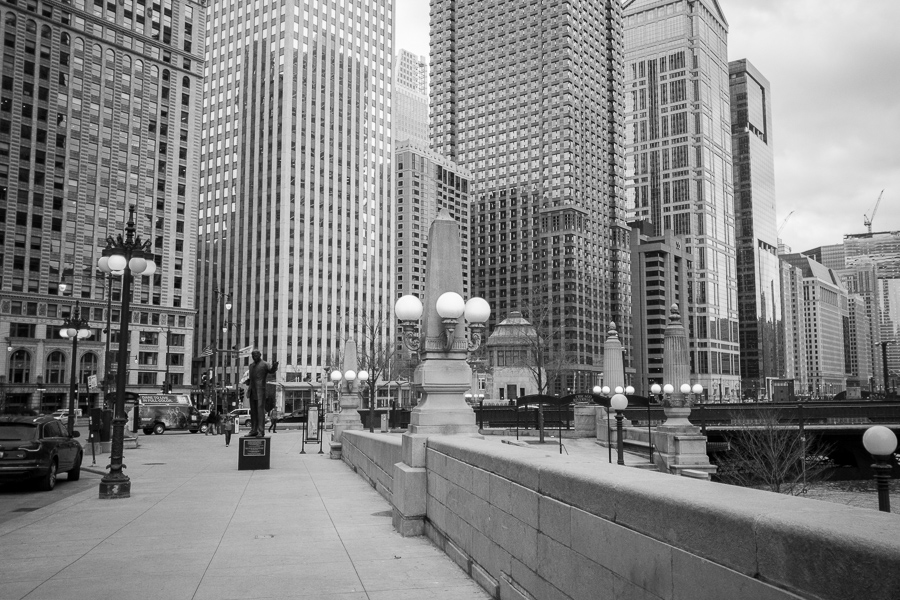It's odd that I haven't posted on a Saturday since January 23rd, and I haven't posted on both weekend days since December 5th-6th. I'm not sure why, really.
This time, it's because last night I had a big party, so I didn't have any time to post. Today I have no creativity. But I still wonder at the pattern.
Sears, Roebuck & Co. was founded only a couple years after the Chicago fire (and the Apollo Chorus). For decades people equated the Sears brand with mail-order retail. They could deliver anything, anywhere, and people in rural 19th- and early-20th-century America depended on them. Their success and business acumen culminated in them commissioning the tallest building in the world just over 40 years ago.
Their current chairman, Eddie Lampert, took over in 2004, and immediately applied the teachings and wisdom of the sociopathic author Ayn Rand to running the august company. He set managers against each other, extracted cash without reinvesting, merged with bankrupt K-Mart, and in the process squandered two-thirds of the company's value—$6 billion just since 2012.
The company took another step to total collapse this week when they announced that they planned to write down the value of the name "Sears" by $200 million. This came in its official report that included dry but painful descriptions of its unbelievably bad Christmas season and its continuing hemorrhaging of cash and people.
The slow death of Sears by Lampert's hands is just sad. Lampert's ideology, and probably his narcissism, have killed one of America's biggest names. I don't think we've ever seen a better example of what happens when Ayn Rand's beliefs go up against reality.
In the last 40 years, astronomers have gathered more and more evidence that our moon came out of a scarcely-imaginable collision between a baby (100-million-year-old) Earth and another proto-planet named Theia. (Watch this video for a good explanation.) Just two weeks ago, astronomers at UCLA announced a clarification: Theia didn't hit Earth in a glancing blow, as previously thought. Instead, the two planets hit head-on:
“We don’t see any difference between the Earth’s and the moon’s oxygen isotopes; they’re indistinguishable,” said Edward Young, lead author of the new study and a UCLA professor of geochemistry and cosmochemistry.
The fact that oxygen in rocks on the Earth and our moon share chemical signatures was very telling, Young said. Had Earth and Theia collided in a glancing side blow, the vast majority of the moon would have been made mainly of Theia, and the Earth and moon should have different oxygen isotopes. A head-on collision, however, likely would have resulted in similar chemical composition of both Earth and the moon.
“Theia was thoroughly mixed into both the Earth and the moon, and evenly dispersed between them,” Young said. “This explains why we don’t see a different signature of Theia in the moon versus the Earth.”
So why am I reviewing catastrophic astronomical events? I'm reading Neal Stephenson's latest novel, Seveneaves, which posits (in its opening paragraph) the collision between our moon and what is probably a small black hole. Stephenson imagines what would happen from a serious, scientific perspective.
Seveneves isn't what you would call a character piece. I'm 45% through it, according to my Kindle, and thoroughly fascinated. But Stephenson is almost the anti-Ishiguro.
Another aside: I have to see the tidal bore in the Bay of Fundy someday. It just sounds so cool—especially in context.
I have three books in the works and two on deck (imminently, not just in my to-be-read stack) right now. Reading:
On deck:
- Kevin Hearne, "Iron Druid Chronicles" book 8: Staked.
- Kim Stanley Robinson, "Mars" trilogy book 2: Green Mars.
Meanwhile, I have these articles and blog posts to read, some for work, some because they're interesting:
Time to read.
Meanwhile, I seem to have a cold. Yuck.
I've meant to post this for a while. Here's a photo looking south-west from a point just southwest of the intersection of Wacker and Michigan, here in Chicago, in April 1986:

And here's a similar view today. Note that you can no longer see the Thompson Center, City Hall, or anything else beyond the row of skyscrapers erected on Wacker between Wabash and Clark since then:

The photos aren't from the same vantage point, because this afternoon I only had my phone and not my SLR. I will try to get a photo from approximately the same location and using the same focal length (probably 210mm) soon.
On this day 180 years ago (28 January 1836), John L. Wilson purchased 33 hectares of land about 16 km from the city, by what is now 83rd and Cottage Grove. At the time it was a swath of prairie two hours outside Chicago. But through a series of missteps, slow City workers, and a very long-lived lawsuit, no one developed the land until 1940, by which time the city had grown to surround the lot on all sides:
The property was so remote—and the value so depressed—that nobody paid much attention to it for nearly 40 years. Then, in 1875, Isaac Palmer discovered that the original land patent had been issued in his name by mistake. He decided to cash in on it.
So now the matter went to the Superior Court of Cook County. By the time the Illinois Supreme Court got the case, the City of Chicago was involved, as well as the successors to Wilson and Palmer. In 1887 the Supreme Court ruled that the Wilson successors had legal title to the property. The City of Chicago also had a valid mortgage of $1,500 against it, with 10% annual interest dating back to the unpaid October 1836 mortgage.
Except there was yet another complication—most land records had been lost in the 1871 Chicago Fire. The further details of the dispute don’t need to be elaborated here, except to say that many lawyers were kept busy over the next fifty years, with the 80-acre plot remaining vacant while the rest of the area was built up.
On August 4, 1939 the drama ended. Compound interest over 102 years had ballooned the defaulted $1,500 mortgage to $34,755,000. Because of all the mistakes various governments had made over the years, Janet Fairbank—the last holder in the chain of title from original patentee John L. Wilson—was allowed to settle the debt and have clear title to the property on payment of $30,000.
For what it's worth, $1,500 in 1837 is about $38,000 today, and $34.8m in 1939 is around $590m today.
On this day in 1986, the Space Shuttle Challenger exploded over the Atlantic Ocean:
A little more than a minute after launch and high above Kennedy Space Center, shuttle Challenger was ripped apart after failure of a rubber seal allowed a spurt of rocket flame to ignite the spacecraft's giant fuel tank.
The roiling plume of Challenger's disintegration would sear an image in the nation's psyche that spoke of a particular sorrow; among seven astronauts killed 30 years ago [today] was teacher Christa McAuliffe.
"We will never forget them," said President Ronald Reagan in a broadcast hours later evoking triumph from tragedy. "The Challenger crew was pulling us into the future, and we'll continue to follow them."
Studying the decisions that led to Challenger launching that day uncovered serious cultural problems within NASA. It also led to groupthink about groupthink as people continually mis-applied the lessons from the disaster after not actually understanding them.
I remember exactly when I heard about the disaster: I was taking a final exam in high school when the PA broke in to tell everyone it had happened. (We still had to finish the exam.)
President Obama and I have the same fitness tracker. His, however, has some customizations:
What counts as must-have features for many people — high-definition cameras, powerful microphones, cloud-connected wireless radios and precise GPS location transmitters — are potential threats when the leader of the free world wants to carry them around.
And so using the latest devices means more than merely ordering one on Amazon for delivery to 1600 Pennsylvania Avenue. It means accepting the compromises imposed by White House technology experts, whose mission is to secure the president’s communications, and by the Secret Service agents who protect him.
He has not given up, though. Mr. Obama is the first commander in chief to regularly carry a specially secured BlackBerry. He reads briefings and checks scores from ESPN on an iPad (the first of which was given to him by Steve Jobs before its public release). And recently he has been seen wearing the Fitbit Surge, a fitness band packed with all the latest technology, on his left wrist.
The article goes on to speculate (because neither the Secret Service nor Fitbit will comment on presidential security) just which features, exactly, they've removed. And my friend request has so far gone unanswered...
Britons, concerned about the decline of one of their most popular (and useful) species, have found a simple helper for them:
Gary Snyder has holes in his garden fence.
That's not normally the kind of oversight you'd find in a well-kept British garden in a market town like Chipping Norton, 75 miles northwest of London. But the holes are there for a reason: hedgehogs.
Snyder's backyard is now one small rest stop on what conservationists hope will be a network of hedgehog superhighways crisscrossing Britain.
The British Hedgehog Preservation Society has been encouraging people throughout Britain to do the same thing, calling it the Hedgehog Street project. A couple of inches of clearance means that hedgehogs can truck right through suburbia as if it didn't exist.
The NPR article even has a David Attenborough video of hedgehogs mating, if you're curious. Because David Attenborough.